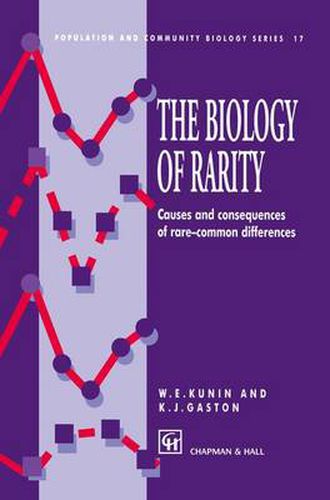Readings Newsletter
Become a Readings Member to make your shopping experience even easier.
Sign in or sign up for free!
You’re not far away from qualifying for FREE standard shipping within Australia
You’ve qualified for FREE standard shipping within Australia
The cart is loading…






This title is printed to order. This book may have been self-published. If so, we cannot guarantee the quality of the content. In the main most books will have gone through the editing process however some may not. We therefore suggest that you be aware of this before ordering this book. If in doubt check either the author or publisher’s details as we are unable to accept any returns unless they are faulty. Please contact us if you have any questions.
Most of what we know about the biological world comes from the study of common species, but most species are rare. The bias in our knowledge-base is of particular concern because rare and common species may, and indeed often do, differ in more ways than just their abundance patterns. The editors of this volume had previously reported in the literature a repeated pattern of low dispersal abilities, high levels of self-compatibility, and low reproductive effort among rare species. The purpose of this volume is to further document the existence of rare-common differences and to elucidate the various processes that may contribute to their creation. Rare species and the subject of rarity itself have gained increasing attention in recent years. This book addresses an aspect of their biology, bringing insights from a variety of disciplines to bear on the causes and implications of differences between rare and common species. The book should interest not only those concerned with rare species but also those of more theoretical leanings, as it addresses the fundamental question of how various ecological and evolutionary processes can contribute to the formation of pattern.
$9.00 standard shipping within Australia
FREE standard shipping within Australia for orders over $100.00
Express & International shipping calculated at checkout
Stock availability can be subject to change without notice. We recommend calling the shop or contacting our online team to check availability of low stock items. Please see our Shopping Online page for more details.
This title is printed to order. This book may have been self-published. If so, we cannot guarantee the quality of the content. In the main most books will have gone through the editing process however some may not. We therefore suggest that you be aware of this before ordering this book. If in doubt check either the author or publisher’s details as we are unable to accept any returns unless they are faulty. Please contact us if you have any questions.
Most of what we know about the biological world comes from the study of common species, but most species are rare. The bias in our knowledge-base is of particular concern because rare and common species may, and indeed often do, differ in more ways than just their abundance patterns. The editors of this volume had previously reported in the literature a repeated pattern of low dispersal abilities, high levels of self-compatibility, and low reproductive effort among rare species. The purpose of this volume is to further document the existence of rare-common differences and to elucidate the various processes that may contribute to their creation. Rare species and the subject of rarity itself have gained increasing attention in recent years. This book addresses an aspect of their biology, bringing insights from a variety of disciplines to bear on the causes and implications of differences between rare and common species. The book should interest not only those concerned with rare species but also those of more theoretical leanings, as it addresses the fundamental question of how various ecological and evolutionary processes can contribute to the formation of pattern.